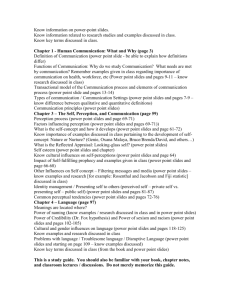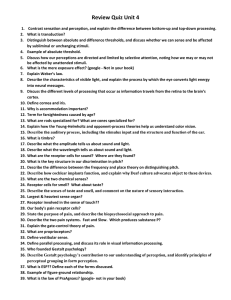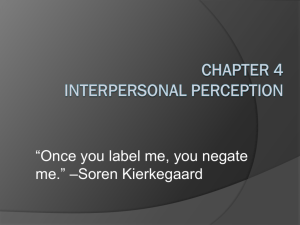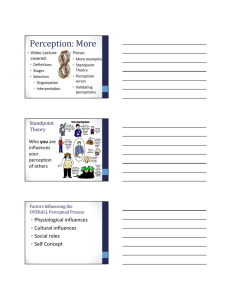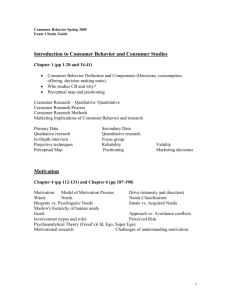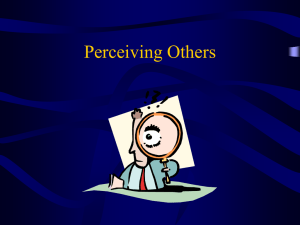Ch. 4 Perception
advertisement
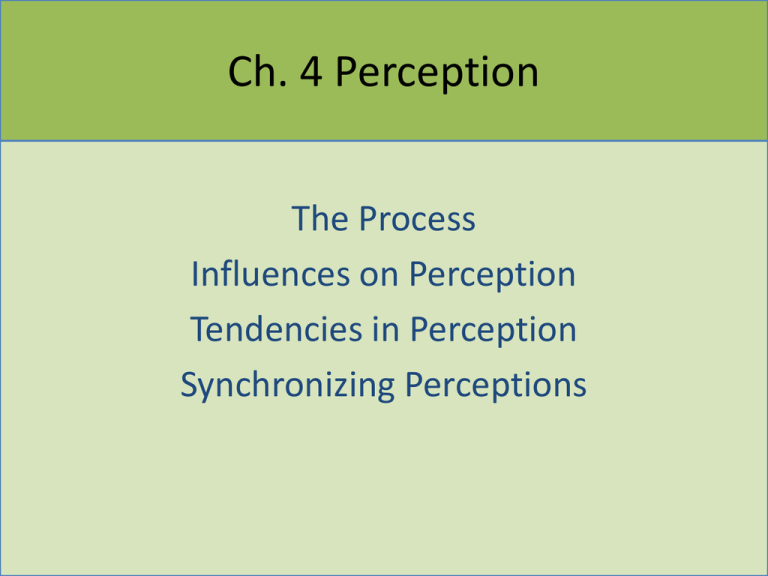
Ch. 4 Perception The Process Influences on Perception Tendencies in Perception Synchronizing Perceptions The Perception Process Reality is constructed: We create it through communication. • First-order reality: physically observed qualities of a thing or situation; these are tangible, factual. • Second-order reality: meanings assigned to firstorder things/situations. These reside in our minds, & are not facts. (Watzlawick, 1990) – When second-order realities are not shared with others, communication problems can happen. 4 Steps in the Perception Process 1) Select data= We’re attracted to intense stimuli, different, repeated, contrasted or changed stimuli. 2) Organize it= We arrange/classify it in 4 meaningful ways to give it order (a perceptual schema) - Physical constructs (appearance) - Role constructs (social position-student, boss, etc.) - Interaction constructs (social behavior-friendly, rude, etc.) - Psychological constructs (internal states of mind & dispositions- confident, insecure, etc.) - Punctuation= determining causes & effects in interactions “I did this b/c you did that.” (It leads to circular arguing & blaming, so focus on how to make it better instead.) Steps in Perception Process 3) Interpret it= We make sense of it, affected by relational satisfaction, expectations, personal experiences & assumptions about human behavior. 4) Negotiate it=We influence each other’s perceptions through communicating narratives. Shared ones=smoother communication, better relationships if common ground is found, even if untrue. Influences on Perception Physiological (physical environment & our senses) • Senses: We perceive through our senses, but it may differ per person. • Age: With age come greater scope & # of experiences, changing point of view. • Health/fatigue: Both affect your and others’ perceptions. • Hunger: more school suspensions and fights • Biological Cycles: different sleep patterns affect relating to each other (morning or night person) • Neurobehavioral Challenges: Many psychological conditions influence our perceptions. (AD-HD, bipolar disorder, etc.) Influences on Perception (cont.) es Psychological: Mood: Our judgments indicate our attitudes. (Lebula & Lucas, 1945) – A relationship exists between mood & happiness. – What you expect will happen does shape what happens. • Self-Concept: single greatest factor in interpreting others’ motives and our responses (behavior). Influences on Perception (cont.) Social Influences • Standpoint Theory: Your position in society shapes your view of it & individuals in it. – Personal experiences & social expectations= very powerful – Being in a majority or a marginalized group affects how you view the world. – Often describes different perspectives of more/less powerful groups & of men vs. women • Sex & Gender Roles: males and females each have 4 psychological sex types (masculine, feminine, androgynous, & undifferentiated). (Bem, 1974) (8 categories) – “Gender”= which psychological sex type. • Androgynous type has larger group of behaviors, deciding by relationship, context, & other variables. • Occupational Roles: Frequently govern perceptions. – “What we are is determined…by society’s <idea> of who we are.” p. 121 Experiment: guards’ and prisoners’ behaviors Cultural Perceptual Influences • Cultural selection, organization, interpretation and negotiation differ between and within countries. • Value of talk differs – Western cultures value talk; silence can be uncomfortable. – Asian cultures value silence; talkative persons =show-offs. – Understanding/respecting differences helps us adapt when communicating. • Behavior differs – Hmong Shamans vs. American Doctors – Geography between nations or within regions or cocultures Perceptual Tendencies • Attribution= the attaching of meaning to behavior. Inaccurate attributions are related to perceptual tendencies. – SNAP JUDGMENTS • BAD W/O ENOUGH INFORMATION • BETTER IF WITH EXPERTISE AND EXPERIENCE • STEREOTYPING - EXAGGERATED BELIEFS IN A CATEGORIZING SYSTEM – RECOGNIZABLE BUT NOT SIGNIFICANT TRAITS – BELIEVING TRAITS BELONG TO MOST OR ALL OF A GROUP – APPLYING THE GENERALIZATION TO A SPECIFIC PERSON (WE SEEK BEJAVIORS THAT SUPPORT IT!) – CLINGING TO 1ST IMPRESSIONS • CONFIRMATION BIAS: SEEK & ORGANIZE IMPRESSIONS TO SUPPORT OPINIONS • HALO EFFECT: TENDENCY TO FORM POSITIVE IMPRESSION FROM ONE POSITIVE CHARACTERISTIC; INTERVIEWERS, ETC. (IF MEN LIKE KIDS, WOMEN PERCIEVE AS MORE ATTRACTIVE.) Perceptual Tendencies cont. • SELF-SERVING BIAS: We judge selves more generously than others (Pal, 2007) – Common in conflicts – Stronger in troubled relationships – We’re more influenced by negative traits than positive ones. • INFLUENCED BY EXPECTATIONS: Foreknowledge influences. – Important when making decisions (blind review) – Can be positive or negative • INFLUENCED BY THE OBVIOUS: We select noticeable stimuli, but obvious factors may not be only or most significant ones. – Gather ALL facts before arriving at a conclusion. (avoid using gossip) • WE ASSUME OTHERS ARE LIKE US: We imagine others’ views are similar to ours, but they may not be. Don’t assume your views are accurate or unbiased. – Ask directly , check with others, or make educated guess after thinking it through. Synchronizing Our Perceptions Faulty perceptions can generate defensiveness, which harms communication exchanges, so USE PERCEPTION CHECKing! (3 parts needed) 1) Describe observed behavior; 2) Give 2 possible interpretations of it; 3) Request clarification Do one now! • It’s a useful strategy to clarify, to save face for others, or to raise a sensitive issue b/c it reduces defensiveness. • Low-context, talkative cultures can appreciate a straight - talking approach. “Did you wear my shirt b/c yours was dirty or b/c you forgot ask if you could borrow it? What was it?” • High-context, social harmony cultures appreciate more indirect communication. Synchronizing Perceptions USE EMPATHY! Experiencing another’s perception isn’t giving up your own. Not Sympathy, which understands (but doesn’t share) the other’s emotions – Perspective taking: Understanding the other’s point of view (thinking) – Emotional contagion: experiencing others’ feelings (affective dimension) – Genuine concern: sincerity for the welfare of the other. VALUE OF : increases self-esteem, comfort level, & ability to trust ETHICS OF : the Golden Rule=clear relationship of empathizing an accepting society’s ethical principles. (in victims’ shoes) empathy = hardest w/those very unlike us – Need open-mindedness = understanding – Imagination = picture the other’s background and thoughts – Commitment = desire to understand despite unfamiliar, confusing information REQUIREMENTS FOR: Remember: Perceptual Influences of Physiological Distortion, Psychological Interference & both Social & Cultural Conditioning - cause us to be insulated from others & - affect how we perceive, but working on empathy with open-mindedness, imagination, and commitment will create more satisfying relationships! 8)
